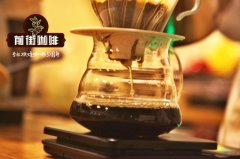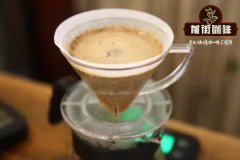Hand-brewing coffee teaching can hand-brew coffee make lattes? five techniques of hand-brewing coffee

Professional coffee knowledge exchange more coffee bean information please follow the coffee workshop (Wechat official account cafe_style)
Hand punch 1
1. Brief introduction of appliances:
1. "thin-mouth kettle": the small-mouth kettle can effectively control the size and stability of the water column (including whether the stability of the water column continues to be good when the water level drops).
two。 "filter paper": choose filter paper of the same size according to the size of the filter cup, and the material of the filter paper will also affect the flow rate.
3. "Upper seat-filter cup": the material is related to the effect of temperature retention in the brewing process, and the hole mesh is related to the flow rate of coffee leakage.
4. "bottom seat-glass pot": it is marked with the amount of water or the number of cups, so it is easy to observe whether the amount of water dripping is enough.
5. "thermometer": you can know the cause of temperature more accurately. Usage: the temperature measuring point is in the middle of the water, do not directly contact the thermometer to the bottom.
6. "Bean grinder": in addition to helping the freshness, the size of grinding particles is also an important factor.
Second, basic concepts:
1. The ratio of water to powder in hand-brewed coffee: usually when you buy a filter cup, you will attach a coffee spoon, about 8g per flat spoon. The advantage of drinking light hand-made coffee is that it can pull away the flavor of fresh coffee beans. The ratio of coffee powder to water is about 1g of coffee powder to 10c.c. Water, so a glass of 150c.c. About two flat tablespoons of coffee powder are used for coffee.
two。 The emphasis can be placed on not breaking the water column (tick-tock appearance) and whether the coffee in the next seat reaches the target. Most beginners pay too much attention to the circle and fail to notice the amount of water, making the coffee too weak.
Hand flush 2
3. Water column: the water in the kettle will wobble greatly because of the inertia caused by the circle, making the outlet water from large to small.
4. Circle: the purpose of making a circle by hand is like stirring. The back and forth circle of the water column is the action of stirring the coffee powder on the surface. In the circle, you can see that the color of the coffee powder washed by the water is different from the others, as long as the color gradually rushes the powder layer evenly.
5. The height of the outlet: the higher the distance from the outlet to the powder layer, the greater the impact on the powder layer.
6. Soaking time: the size of water column, the thickness of coffee powder and the pore size of the filter cup will affect the speed of coffee outflow.
III. Usage
'filter paper folding'
Fold back and forth according to the stitches on both sides of the filter paper, and then stretch them out.
'Control of the size of the water column'
'Operation steps'
1. Put the filter cup on the glass pot.
two。 Pour hot water into the pot and insert it into the thermometer.
3. Fold the filter paper and make it stick to the filter cup.
4. Pour the filter paper with hot water so that the filter paper is pasted flat on the filter cup and warm the filter cup and the glass pot at the same time.
5. Pour the coffee powder into the filter cup, pick up the filter cup and pat the side with your hand to make the coffee powder surface slightly flat.
6. Start from the center point of the filter cup, around the center to the periphery and back to the center as a circle.
7. Wet the coffee powder on the first lap and stop (do not drop too much coffee water, 3 drops is the standard)
8. Take a look at the development of the bubble, about 40 seconds (when the bubble collapses, it begins to burst)
9. Then repeat the circle, rinse to the required amount of water (usually a cup of 150-180cc).
'detailed illustration'
"first lap": steaming-soaking coffee powder evenly, start timing
"the second lap": let the powder layer develop upward
The third lap: the amount of coffee made to a cup of coffee. At this time, the foam is whitening and most of the material has been washed out.
[four major causes]
Temperature
1. Extraction efficiency: the temperature of water affects the extraction efficiency of coffee. If the coffee is too bitter and scorched, try lowering the temperature. On the other hand, if you feel that there is still a lot of flavor unreleased, you can consider raising the temperature. two。 The development of the powder layer: another noteworthy place is the development of the powder layer. The powder layer contains bubbles, which are full of coffee liquid and air. The denser the bubbles, the better the effect of soaking in the filter droplets. In the case of shallow baked beans or grinding too fine, the powder layer is not easy to expand, we can consider increasing the water temperature to assist the development of the powder layer.
Grinding thickness
The thickness of powder has a high influence on the flow rate and the development of powder layer. Extraction efficiency: the finer the grinding, the more the number of particles, the greater the extraction efficiency. two。 Powder layer development: usually the fresher the coffee beans, the better the powder layer will swell. However, if the grinding is too rough, because the water passes quickly, it is disadvantageous to the development of the powder layer. When grinding is too fine, because the water is not easy to pass, it will get stuck on the powder, and the development of the powder layer is not good, so the appropriate grinding thickness must be used. (in the case of Pegasus and Eagle, about 3.0 Murray 3.5)
Baking degree
1. Shallow roasting: shallow roasted coffee beans are relatively dense, it is recommended to use a high temperature of more than 90 ℃ and a smaller water column, so it is easier to rush out the flavor. two。 Deep baking: the deeper the baking, the looser the tissue structure, the faster the extraction efficiency of soluble matter, the better water absorption, the powder layer is easy to expand by water, but the bitter taste is relatively heavy. 3. Therefore, the suggestions on the degree of baking and temperature are as follows: shallow baking: the temperature is about 90murmur92 degrees. After boiling, pour into a copper pot and bake deeply: the temperature is about 88mur90.
Soaking time
1. Extraction efficiency: the longer the soaking time, the greater the extraction efficiency. two。 The overall cooking time is about 3 minutes, and the size of the water column can be adjusted as close to the target time as possible.
Grinding thickness
The temperature of water
The roasting depth of coffee beans
Extraction efficiency
Fine
High
Deep
Come on!
Coarse
Low
Shallow
Slow
[time and flavor of extraction]
It is not that the more ingredients are extracted, the better, just like tea soaked in hot water, the shorter the time, the more tasteless; but for a long time, it is prone to miscellaneous taste, astringency and other uncomfortable taste. The goal of our extraction is to find the most suitable point, so that there is more pleasant taste and less uncomfortable taste as much as possible.
Important Notice :
前街咖啡 FrontStreet Coffee has moved to new addredd:
FrontStreet Coffee Address: 315,Donghua East Road,GuangZhou
Tel:020 38364473
- Prev

The meaning of the Golden Cup guidelines of scaa Standard hand-brewed Coffee course how much hand-brewed coffee per person
Professional coffee knowledge exchange more coffee bean information Please pay attention to the brewing ratio in the coffee workshop (Wechat official account cafe_style) refers to the ratio of coffee powder to the amount of water extracted, which directly affects the extraction rate of coffee powder and the concentration of coffee liquid. The European and American gold cup criterion is to use the amount of powder and water as the control tool of the follicular coffee tube table, and its complexity and importance are more important than freshness and thickness.
- Next

How to use KONO filter Cup how to use KONO filter Cup to make Coffee Coffee filter Cup
Professional coffee knowledge exchange more coffee bean information Please pay attention to the coffee workshop (Wechat official account cafe_style) different from other hand brewing methods, the KONO hand brewing method does not need to be steamed, but with a special hand brewing pot and a tapered filter with short ribs, with a single hand brewing method. The whole process is continuous and gradual, and so is the thickness of the flow. To subdivide, from the tiniest and smallest
Related
- Beginners will see the "Coffee pull flower" guide!
- What is the difference between ice blog purified milk and ordinary milk coffee?
- Why is the Philippines the largest producer of crops in Liberia?
- For coffee extraction, should the fine powder be retained?
- How does extracted espresso fill pressed powder? How much strength does it take to press the powder?
- How to make jasmine cold extract coffee? Is the jasmine + latte good?
- Will this little toy really make the coffee taste better? How does Lily Drip affect coffee extraction?
- Will the action of slapping the filter cup also affect coffee extraction?
- What's the difference between powder-to-water ratio and powder-to-liquid ratio?
- What is the Ethiopian local species? What does it have to do with Heirloom native species?

